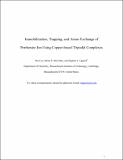| dc.contributor.author | Cao, Rui | |
| dc.contributor.author | McCarthy, Brian D. | |
| dc.contributor.author | Lippard, Stephen J. | |
| dc.date.accessioned | 2012-10-17T19:40:57Z | |
| dc.date.available | 2012-10-17T19:40:57Z | |
| dc.date.issued | 2011-08 | |
| dc.date.submitted | 2011-05 | |
| dc.identifier.issn | 0020-1669 | |
| dc.identifier.issn | 1520-510X | |
| dc.identifier.uri | http://hdl.handle.net/1721.1/74058 | |
| dc.description.abstract | We describe a multidentate tripodal ligand in which three pendant arms carrying di(2-picolyl)amine units are linked to the ortho positions of a tris(o-xylyl) scaffold, providing N(CH[subscript 2]-o-C[subscript 6]H[subscript 4]CH[subscript 2]N(CH2py)[subscript 2])[subscript 3] (L). Reaction of L with CuCl[subscript 2] in the presence of hexafluorophosphate anion afforded blue cubes of [(CuCl)[subscript 3]L](PF[subscript 6])[subscript 3]·5H[subscript 2]O (1). Crystallographic studies of 1 revealed that the three symmetry-related arms each coordinate a {Cu[superscript II]Cl} unit, and two molecules of 1 are connected to one another through a Cu(μ-Cl)[subscript 2]Cu bridge, extending the molecular structure to form a two-dimensional (2-D) layer. These 2-D layers pack in an ABCABC... fashion with PF[subscript 6]– anions located in between. Reaction of 1 with a stoichiometric amount of perrhenate ion afforded blue plates of [(CuCl)[subscript 3]L](PF[subscript 6])(ReO[subscript 4])[subscript 2]·3H[subscript 2]O (2). Compound 2 has the same lattice structure as 1, but the tricopper unit backbone now traps one ReO[subscript 4]– anion through Coulombic interactions. In addition, three molecules of 2 are bridged by a perrhenate ion, forming a Cu[subscript 3](μ[superscript 3]-ReO[subscript 4]) cluster, to give a different 2-D structure displaying a rare tridentate bridging ReO[subscript 4]– mode. Thus, in addition to classic perrhenate trapping through weak Coulombic interactions, 2 represents an exceptional example in which the ReO[subscript 4]– anion is immobilized in an extended framework through tight covalent interactions. The interlamellar PF[subscript 6]– anions in 1 can be exchanged with other anions including perrhenate, perchlorate, or periodate. The structural similarity between perrhenate and pertechnetate makes these materials of potential interest for pertechnetate trapping. | en_US |
| dc.language.iso | en_US | |
| dc.publisher | American Chemical Society (ACS) | en_US |
| dc.relation.isversionof | http://dx.doi.org/10.1021/ic201172r | en_US |
| dc.rights | Creative Commons Attribution-Noncommercial-Share Alike 3.0 | en_US |
| dc.rights.uri | http://creativecommons.org/licenses/by-nc-sa/3.0/ | en_US |
| dc.source | Prof. Lippard via Erja Kajosalo | en_US |
| dc.title | Immobilization, Trapping, and Anion Exchange of Perrhenate Ion Using Copper-Based Tripodal Complexes | en_US |
| dc.type | Article | en_US |
| dc.identifier.citation | Cao, Rui, Brian D. McCarthy, and Stephen J. Lippard. “Immobilization, Trapping, and Anion Exchange of Perrhenate Ion Using Copper-Based Tripodal Complexes.” Inorganic Chemistry 50.19 (2011): 9499–9507. | en_US |
| dc.contributor.department | Massachusetts Institute of Technology. Department of Chemistry | en_US |
| dc.contributor.approver | Lippard, Stephen J. | |
| dc.contributor.mitauthor | Cao, Rui | |
| dc.contributor.mitauthor | McCarthy, Brian D. | |
| dc.contributor.mitauthor | Lippard, Stephen J. | |
| dc.relation.journal | Inorganic Chemistry | en_US |
| dc.eprint.version | Author's final manuscript | en_US |
| dc.type.uri | http://purl.org/eprint/type/JournalArticle | en_US |
| eprint.status | http://purl.org/eprint/status/PeerReviewed | en_US |
| dspace.orderedauthors | Cao, Rui; McCarthy, Brian D.; Lippard, Stephen J. | en |
| dc.identifier.orcid | https://orcid.org/0000-0002-2693-4982 | |
| mit.license | OPEN_ACCESS_POLICY | en_US |
| mit.metadata.status | Complete | |
